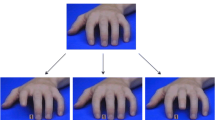Abstract
In everyday life we must constantly balance our intentions to act in a certain way with reactions that are imposed upon us by the outside world. Recent neuroimaging studies have examined these classes of movement separately but despite the fundamental requirement for us to efficiently organize our internally generated and externally triggered actions, few studies have examined the relationship between these two classes of movement. We measured EMG activity in the right first dorsal interosseous while subjects performed right index finger key presses either in an internally generated condition or an externally triggered condition. In addition, in an attempt to probe the relationship between the processing underlying these two types of action, we examined the effect on reaction time (RT) and EMG activity in a third “truncation” condition in which subjects were forced to switch from an intentional (internally generated) mode of response production to an externally triggered mode. Results indicated significantly greater muscle activation for actions that were internally generated as compared to externally triggered. Truncation caused responses to be delayed by, on average, 54.7 ms as compared with simple externally triggered responses, suggesting that the motor system cannot take advantage of preexisting levels of preparation when switching between internally generated and externally triggered actions. Interestingly, the unique EMG signatures of internally generated and externally triggered actions were preserved in truncation. Thus, subjects switched between the two types of action rather than simply modifying an ongoing action. The results provide peripheral physiological support for previous neuroimaging work suggesting that internally generated actions are preceded by greater levels of preparation than externally triggered actions. The present findings also raise the interesting possibility that the motor system processes these two classes of action separately even though the motor output required is the same.



Similar content being viewed by others
References
Astor-Jack T, Haggard P (2004) Intention and reactivity. In: Humphreys GW, Riddoch MJ (eds) Attention for action. Elsevier (in press)
Boccardi E, Della Sala S, Motto C, Spinnler H (2002) Utilisation behaviour consequent to bilateral SMA softening. Cortex 38:289–308
Broadbent DE (1958) Perception and communication. Pergamon, Oxford
Cunnington R, Windischberger C, Deecke L, et al (2002) The preparation and execution of self-initiated and externally-triggered movement: a study of event-related fMRI. Neuroimage 15:373–385
Deecke L (1990) Electrophysiological correlates of movement initiation. Rev Neurol (Paris) 146:612–619
Dettmers C, Ridding MC, Stephan KM, Lemon RN, Rothwell JC, Frackowiak RS (1996) Comparison of regional cerebral blood flow with transcranial magnetic stimulation at different forces. J Appl Physiol 81:596–603
Deubel H, Schneider WX (2003) Delayed saccades, but not delayed manual aiming movements, require visual attention shifts. Ann N Y Acad Sci 1004:289–296
Halsband U, Matsuzaka Y, Tanji J (1994) Neuronal activity in the primate supplementary, pre-supplementary and premotor cortex during externally and internally instructed sequential movements. Neurosci Res 20:149–155
Jahanshahi M, Jenkins H, Brown RG, Marsden CD, Passingham RE, Brooks DJ (1995) Self-initiated versus externally triggered movements. 1. An investigation using measurement of regional cerebral blood-flow with pet and movement-related potentials in normal and Parkinsons-disease subjects. Brain 118:913–933
Jenkins IH, Jahanshahi M, Jueptner M, Passingham RE, Brooks DJ (2000) Self-initiated versus externally triggered movements II. The effect of movement predictability on regional cerebral blood flow. Brain 123:1216–1228
Passingham RE (1987) Two cortical systems for directing movements (Review). Ciba Foundation Symposium 132:151–164
Passingham RE (1993) The frontal lobes and voluntary action. Oxford Psychology Series No. 21, Oxford University Press
Author information
Authors and Affiliations
Corresponding author
Rights and permissions
About this article
Cite this article
Obhi, S.S., Haggard, P. Internally generated and externally triggered actions are physically distinct and independently controlled. Exp Brain Res 156, 518–523 (2004). https://doi.org/10.1007/s00221-004-1911-4
Received:
Accepted:
Published:
Issue Date:
DOI: https://doi.org/10.1007/s00221-004-1911-4




